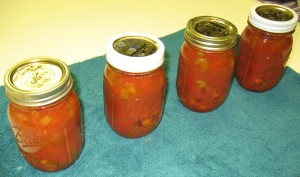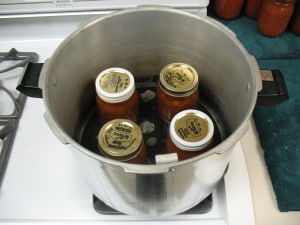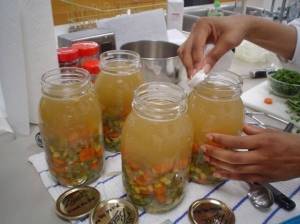
If you happen to be a home food preserver who tucks away your canning equipment snugly and soundly through the winter season, then you might like to know some tips for giving tender loving care to your equipment as you store it. (Note: it doesn’t really require warm gloves.)
To encourage safe operation of your pressure canner in the coming spring and summertime, clean the vent and safety valve. To do this, pull a clean string or narrow strip of cloth through the opening of the vent. Make sure the safety valve is free of debris and moves smoothly, and then remove it for cleaning (or follow manufacturer’s directions). Next, check the gasket, if your canner has one (some are metal to metal instead). The gasket is the rubber or rubber-like ring that helps seal the rim with the lid. Follow manufacturer’s instructions to remove the gasket for cleaning, and if it needs replacing then you should easily find a new one from the manufacturer or at a hardware store. Once again, follow your particular manufacturer’s directions for how to care for the sealing edges of your canner. If you have a dial gauge canner, be sure not to immerse the gauge in water.

If you have an aluminum canner and the inner surface is darkened, clean it by filling it above the darkened line with a mixture of 1 tablespoon cream of tartar to each quart of water. Heat the water to a boil and boil, covered, until the dark deposits disappear. Stubborn deposits may require additional cream of tartar. Once deposits are gone, empty the canner, wash it with hot soapy water, rinse, and dry. A hint for reducing the occurrence of these deposits next canning season: add 1 tablespoon of white vinegar to the water in the canner while you process jars.
To absorb moisture and odors, store the canner with clean paper towels in the bottom and around the rack. Rest the lid on the canner upside-down, so that it does not seal and trap moisture. Designate a clean, dry storage area and use boxes, racks, or other organizational accessories to create a food preservation storage center to which you can also add other cleaned equipment and utensils.

Inventory your jars, checking for chips and breaks. Wash and dry jars and remove any ring bands that may be screwed onto the jars. Wash and dry the ring bands as well, checking for dents and rust. If cared for properly, jars have the potential to last indefinitely, and bands can be used over and over until they rust or get bent. Remember though that flat lids are to be processed in a canner only one time, then discarded (or used creatively for non-canning purposes) after that jar of food is consumed.
Remember too, if you have a dial gauge pressure canner, to mark your calendar now for a time to have your gauge tested in the early spring. Contact your County Extension Agent for information about checking its accuracy. In case it is off by more than 1 pound of pressure, allow enough time to replace the gauge by checking it well in advance of your canning season.
For original source of this information, go to When It’s
Time to Store Canning Supplies… on the National Center for Home Food Preservation website.










You must be logged in to post a comment.